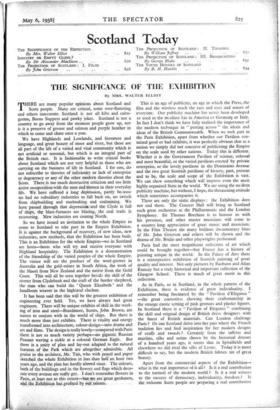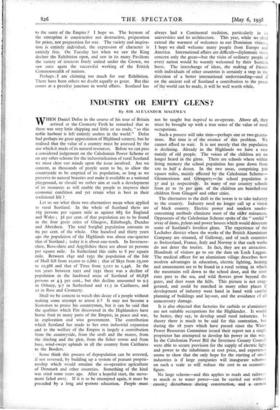Scotland Today
THE SIGNIFICANCE OF THE EXHIBIT ION
By Mrs. Walter Elliot . .
INDUSTRY OR EMPTY GLENS ?
By Sir Alexander MacEwen . .
THE PROJECTION OF SCOTLAND: I. FILMS . . .
By John Grierson
THE PROJECTION OF SCOTLAND: II. THEATRES
825 By William Jeffrey . . . . . . . . . . 830
THE PROJECTION OF SCOTLAND: III. BROADCASTING
826 By George Blake . . 832 THE YOUTH HOSTELS OF SCOTLAND 828 By B. H. Humble .. . . 834
THE SIGNIFICANCE OF THE EXHIBITION
By MRS. WALTER ELLIOT
THERE are many popular opinions about Scotland and Scots people. Many are critical, some over-flattering and others inaccurate. Scotland is not all kilts and cairn- gorms, Burns Suppers and pawky jokes. Scotland is not a country to go away from the moment people grow up, nor is it a preserve of grouse and salmon and purple heather in which to come and chase once a year.
We have Highlands and Lowlands, and literature and language, and great beauty of moor and river, but these are all part of the life of a varied and vital community which is not artificial or seasonal, but which is an integral part of the British race. It is fashionable to write critical books about Scotland which are not very helpful to those who are carrying on the business of life in Scotland. I for one, do not subscribe to theories of inferiority or lack of enterprise or degeneracy or any of the other modern theories about the Scots. There is too much destructive criticism and too little active co.-operation with the men and women in their everyday life. We have suffered a long depression, partly be:ause we had no subsidiary industries to fall back on, no switch from shipbuilding and steelmaking and coalmining. We have passed through that depression and the Clyde is full of ships, the blast-furnaces are blazing, the coal trade is recovering. New industries are coming North.
So we have issued an invitation to the whole Empire to come to Scotland to take part in the Empire Exhibition. It is against the background of recovery, of new ideas, new industries, new methods, that the Exhibition has been built. This is an Exhibition for the whole Empire—we in Scotland are hosts—hosts who will try and receive everyone with Highland hospitality. The Exhibition is a demonstration of the friendship of the varied peoples of the whole Empire. The visitor will see the product of the wool-grower in Australia and the gold-miner in South Africa, the work of the Maori from New Zealand and the native from the Gold Coast. This will all be seen together besidt the skill of the riveter from Clydebank and the craft of the border shepherd, the man who can build the 'Queen Elizabeth' and the handloom weaver in the highland clachan.
It has been said that this will be the greatest exhibition of engineering ever held. Yes, we have always had great engineers. There will be unique exhibits of skill in the work- ing of iron and steel—Beardmore, Scotts, John Brown, are names to conjure with in the world of ships. But there is much more than just exhibits. There is vitality and energy transformed into architecture, colour-design—into drama and art and films. The design is really lovely—compared with Paris there is not so much variety perhaps—no gigantic Russian Peasant waving a sickle at a colossal German Eagle. But there is a unity of plan and lay-out adapted to the natural features of the Park which are altogether admirable. All praise to the architect, Mr. Tait, who with pencil and paper sketched the whole Exhibition in less than half an hour two years ago, and the plan has hardly altered since. The colours, both of the buildings and in the flowers and flags which deco- rate every avenue are really gay. I don't remember flowers in Paris, at least not to this extent—but we are great gardeners, and the Exhibition haiprofited by our,talents. This is an age of publicity, an age in which the Press, the film and the wireless reach the ears and eyes and senses of everyone. Our publicity machine has never been developed or used as the mzchine has in America cr Germany or Italy. In fact I don't think we have fully realised the importance of the modern technique in "putting across" the ideals and ideas of the British Commonwealth. When we took part in the Paris Exhibition, apart from whether our Pavilion con- tained good or bad exhibits, it was perfectly obvious that as a nation we simply did not conceive of publicising the Empire on the scale used by other nations. Today this is different. Whether it is the Government Pavilion of science, colossal and most beautiful, or the varied pavilions erected by private enterprise, or the lovely pavilions in the Dominions Avenue and the two great Scottish pavilions of history, past, present and to be, the scale and scope of the Exhibition is vast. We can show something which will impress even the most highly organised State in the world. We are using the mcdem publicity machine, but without, I hope, the threatening attitude which sometimes accompanies it.
These are only the static displays : the Exhibition does not end there. The Concert Hall will bring to Scotland such great orchestras as the Philharmonic and the London Symphony. Sir Thomas Beecham is to honour us with his presence, and other master musicians will come to a country long appreciative of great music and musicians. In the Film Theatre the many brilliant documentary films of Mr. John Grierson and others will be shown and the drama of Mr. Bridle and other playwrights performed.
Paris had the most magnificent collection of art which could be brought together—but France has a history of painting unique in the world. In the Palace of Arts there is a retrospective exhibition of Scottish painting of great quality and interest. Not only pictures by Raeburn and Alla,n Ramsay but a truly historical and important collection of the Glasgow School. There is much of great merit in this collection.
As in Paris, so in Scotland, in the whole pattern of the Exhibition, there is evidence of great individuality. I remember being fascinated by the "Pavilion d'Elegance " —the great couturieres showing their craftsmanship in the strange exotic setting of pink grottoes and plaster figures. In Scotland there is a "Pavilion of Elegance" combining the skill and original design of British dress designers with the finest of British materials. Can London challenge Paris ? Or can Scotland delve into her past where the French tradition lies and find inspiration for her modern designs of stuffs and tweeds ? Certainly from the taffetas and muslins, silks and satins shown by the historical dresses of a hundred years ago, it seems that in Spitalfields and elsewhere we did rival the silks of Lyons. Today it is more difficult to say, but the modern British fabrics are of great beauty.
Apart from the commercial aspects of the Exhibition— what is the real importance of it all ? Is it a real contribution to the turmoil of the modern world ? Is it a real witness to the success of democracy, individuality, freedom ? Is the welcome Scots people are preparing a real contribution to the unity of the Empire ? I hope so. The keynote of the enterprise is constructive not destructive, preparation for peace, not preparation for war. The variety and inspira- tion is entirely, individual, the expression of character is entirely free. On Tuesday last when we saw the King declare the Exhibition- open, and saw in its many Pavilions the variety of interests freely united under the Crown, we saw once again the successful working of the British Commonwealth of nations.
Perhaps .1 am claiming too much for our Exhibition. There have been others no doubt equally as great. But this comes at a peculiar- juncture in world affairs. Scotland has always had a Continental tradition, particularly in its universities and its architecture. This year, while we shall extend the warmest of welcomes to our Dominion visitors, I hope we shall welcome many people from Europe and America. International affairs are difficult—diplomatic visits concern only the great—but the visits of ordinary people of every nation would be warmly welcomed by their Scottish hosts. The interchange of ideas, the making of friends with individuals of other countries is certainly a step in the direction of a better international understanding—and if on the ancient soil of Scotland a contribution to the peace of The worldcan be made, it will be well worth while.



































































 Previous page
Previous page